
FS-2021-0581 | October 2022
Urinary Calculi in Male Goats and Sheep
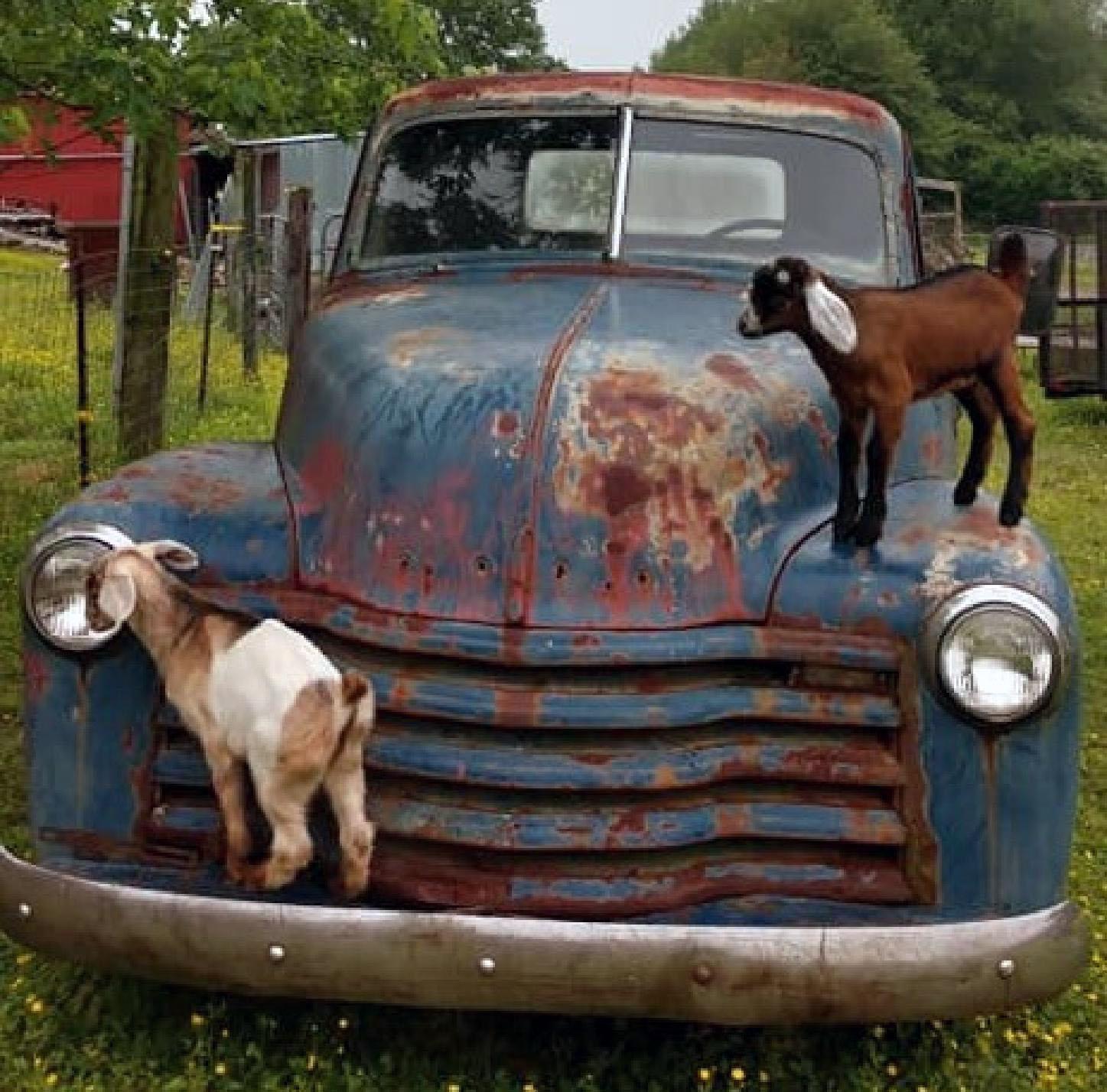
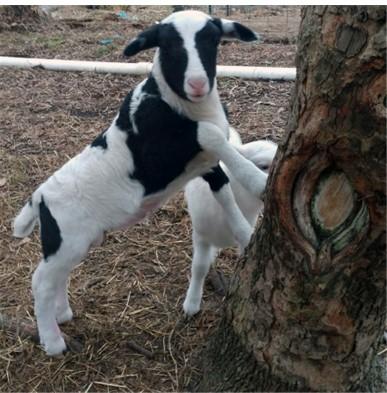
Many small farmers raise sheep and goats because they cost less to feed and need less space than larger livestock. Because of their smaller size and inquisitive personalities, goats are a great option for 4-H projects (Figure 1). Sheep also make good projects for youth (Figure 2). Sheep and smaller breeds of goats have become a popular option for pets in recent years. Videos of goats running around in pajamas have become an internet sensation and helped boost the popularity of miniature breeds.
For many seeking a pet or a 4-H project, wethers (castrated males) are a great option. Wethers are not as aggressive as intact males. Intact male goats also have an offensive odor during breeding season that is not a good quality for a pet. Dairy goat wethers are generally priced much lower than their sisters and are in less demand, making them an affordable option. Many dairy and miniature goat breeders prefer pet homes for their male kids as opposed to having the animals go into the food chain for consumption.
Like all livestock projects, having animals comes with the responsibility to care for the animals’ health and wellbeing. Part of that responsibility involves understanding and preventing diseases. One health problem that many novice goat and sheep producers and pet goat owners fail to recognize is that the males, especially those kept as pets, can be at high risk for urinary calculi. Market wethers kept for livestock shows such as 4-H and FFA are at a particularly high risk of urinary calculi due to intensive feeding programs that involve high amounts of grain and low amounts of roughage.
Urinary Calculi is a Deadly Condition that Can Occur in Male Goats and Sheep
Urinary calculi, also known as “urolithiasis” or “waterbelly,” occurs when sediment (a concentration of mucus, protein and mineral deposits) accumulates in the urinary tract. It can come in the form of very small stones or grit and can eventually build up, leading to an increased risk of a urinary tract infection and may result in a life-threatening obstruction of the urethra (the duct by which urine is carried out of the body from the bladder). The blockage is extremely painful for the animal. The blockage can be fatal because if an animal cannot urinate, the bladder will continue to collect urine and can eventually burst.
While female small ruminants can build up urinary calculi too, they are not likely to become obstructed because they have a shorter urethra. Most urinary calculi in male small ruminants get stuck at the urethral process (a small tube-like extension of skin and urethra at the tip of the penis) or at the distal sigmoid flexure (an S-shaped curve in the lower half of the penis). Some researchers have found that males that are castrated prior to reaching puberty are at higher risk because their urethras do not develop as fully as those castrated at older ages. Testosterone drives the development of the urethra and urethral process, allowing these sites to be larger in diameter in intact males and less likely to become sites of obstruction. Allowing males to reach puberty prior to castration also allows the urethral process to separate from the glans penis, which can make the animal easier to catheterize (Smith and Sherman, 2009). Although the size of the urethra can make it easier for the animal to have an obstruction, unbalanced diets cause urinary calculi development in small ruminants, even in intact males. The Merck Veterinary Manual states, “Ruminant urolithiasis is considered primarily a nutritional disease” (Aiello et al., 2016). Diets that are high in concentrates (grains, phosphorus, and magnesium) and low in roughage (hay or fresh grass) and calcium increase the risk of calculi formation.
Four Compartment Stomachs of Small Ruminants are Designed for Eating Forages such as Grass, Hay and Browsing
Owners of small livestock must remember that goats and sheep are ruminants. Forages should compose most of a sheep or goat’s diet. Ruminants remove phosphorus from their bodies by excreting it into their saliva and then out through their feces (manure). High-grain, low-roughage diets decrease saliva formation, resulting in the kidneys removing the increased phosphorus and excreting it out of the body in urine. This excess phosphorous can settle in the bladder and turn into urinary calculi, leading to increased risk of blockage.
Properly balance any grain given to goats or sheep and feed it in moderation. The dietary calcium-to-phosphorus ratio in the diet should be around 2:1. This ratio may vary slightly depending on location, management, and the mineral content of the water; however, it is important to maintain higher calcium levels than phosphorus. Since excess calcium can also cause urinary calculi, avoid overfeeding calcium. Local feed stores and large, commercial feed companies that sell species-specific bagged feed at large retail stores employ animal nutritionists to ensure that the feed they sell meets the nutrient requirements for the intended species. These feeds are balanced for protein and fat as well as for vitamins and minerals. However, these feeds are designed to be fed as a supplement to a primarily forage diet. Generally, these feeds are available in pelleted and textured forms. Adding ingredients to an already balanced feed as a treat can throw off the mineral balance and result in problems. Many commercial goat feeds also contain ammonium chloride, which helps decrease the pH of the urine and dissolve the stones. Grains such as corn and barley and oilseeds such as sunflower seeds are commonly used as treats; on the other hand, they are high in phosphorus and can cause issues if they are not accounted for when balancing the ration. For larger operations, it may be more economical to purchase bulk grains in order to make a custom feed. It is important to balance the ration accurately and to include the correct minerals to avoid problems. An animal nutritionist or a software application can help you calculate the needed balance. Do not attempt to correct the calcium-to-phosphorus ratio by adding an abundance of calcium to the diet. Excess calcium can also cause urinary calculi and is commonly seen is small ruminants grazing lush clover pastures or being fed alfalfa hay, as these have excess calcium content.
Water is another vital nutrient in preventing a buildup of urinary calculi. Ensuring that animals receive enough water helps them flush the urinary tract. Encourage water intake by providing fresh, clean water at all times. During the winter months, make sure that animals always have access to ice-free water. Offering salt can encourage increased water intake.
It is Critical to Recognize the Symptoms of Urinary Calculi Quickly
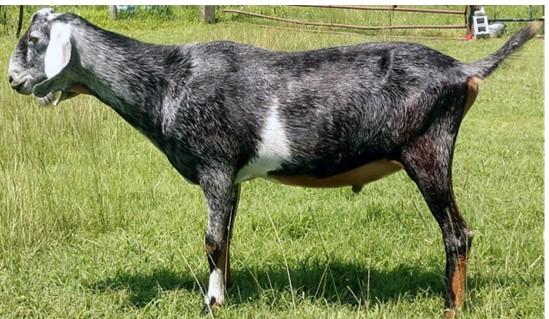
Urinary obstructions can be mistaken for constipation in male small ruminants. Any time a male sheep or goat appears constipated, he should be examined for urinary obstruction. Obstructed small ruminants will posture to urinate (Figure 3) but will have little or no production. Some animals will cry in pain. Obstructed animals may appear lethargic and/or go off feed.
A veterinarian should immediately examine any male sheep and goats suspected of obstruction. The veterinarian may want to x-ray the animal to determine the extent of the obstruction. If a veterinarian cannot examine the animal in a timely manner, the owner can assess the animal by sitting the animal on his rump and extruding his penis (Figures 4 and 5). Once the penis is extruded, the owner can examine the urethral process to feel if there are calculi stuck at this site (Figure 6). If the urethral process is blocked, blood flow can decrease, causing the urethral process to turn white or black. The owner should inform the veterinarian immediately as this is an emergency situation.

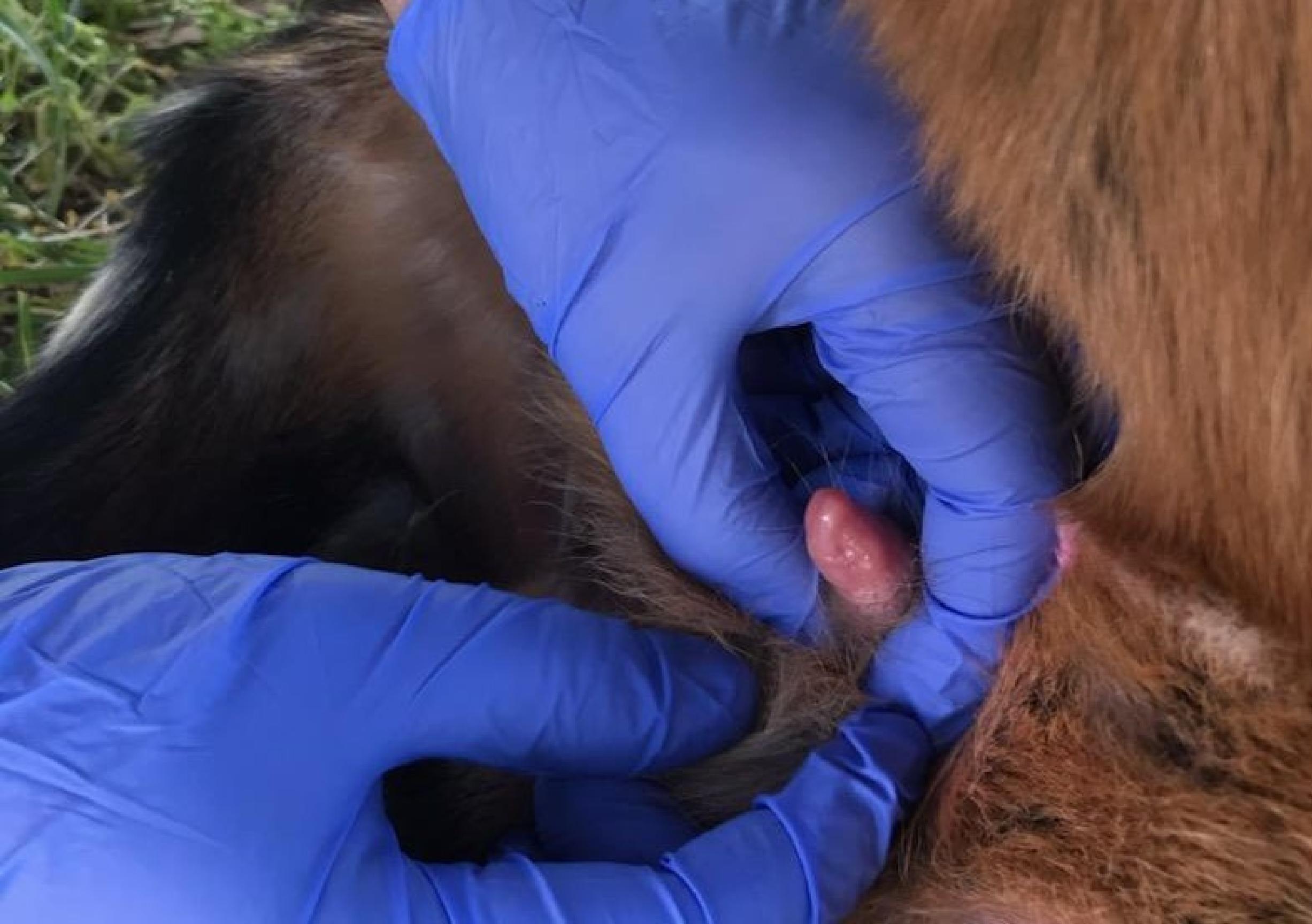
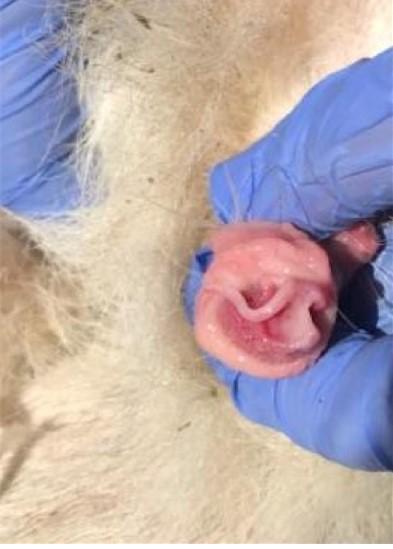
Treatment for Urinary Calculi is not Always Successful
Animals that are treated quickly have a better chance of recovery. Minimal treatment of urinary calculi generally consists of providing pain medication, amputating the urethral process, and administering ammonium chloride. In some cases, an owner will try to treat by snipping the urethral process. For many animals, this will only give temporary relief and the animal should be evaluated by a veterinarian as soon as possible. Because ammonium chloride is a salt, animals generally find it not palatable, and the best way to feed it is in a feed as a prevention. Administering it as a treatment is very difficult as it must be done daily, and animals quickly figure out what is in the syringe, making drenching a challenge.
In most cases, saving the life of a blocked animal requires a veterinarian’s attention. The veterinarian may place a catheter to flush the urinary tract and allow the animal to urinate properly. Some treatments involve having the catheter in place for two weeks (called a “tube cystotomy”). In extreme cases, a perineal urethrostomy (PU) surgery may be required. The surgery creates a permanent opening from the urethra through the animal’s rear end. This surgery leaves the animal unable to breed and therefore is not recommended in high-valued breeding animals. The tube cystotomy is the best option to try to salvage reproductive function in intact breeding males. Any animal with an obstruction requires extra care because no matter the treatment option, obstruction can reoccur. If proper treatment is too costly, the animal should be humanely euthanized. Salvaging the animal through slaughter is also an option if the animal has not received any medications and it can be done in a timely manner.
Prevention is Key when Avoiding Problems with Urinary Calculi
Treatments of urinary calculi are very expensive, there is no guarantee of success, and the problems can reoccur. A good relationship with a livestock veterinarian is crucial to ensure that animals will be examined and treated quickly in the event of an emergency. Animals should be fed a properly balanced ration and have access to ample forage and water. If males are intended to be kept as pets, consult a livestock veterinarian for recommendations prior to castration to ensure that it is performed at the appropriate time so these animals can live long, healthy lives.
References
- Aiello, S., & Moses, M., Allen, D., Constable, P., Dart, A., Davies, P., Quesenberry, K., Reeves, P., & Sharma, J. (Eds.). (2016). The Merck Veterinary Manual (11th ed.). Merck & Co., Inc.
- Smith, M. C., & Sherman, D. M. (2009). Goat Medicine (2nd ed.). Wiley-Blackwell.
MAEGAN PERDUE
mperdue@umd.edu
DR. KIMBERLY BRAXTON, DVM
DR. JONATHAN MOYLE
jmoyle@umd.edu
This publication, Urinary Calculi in Male Goats and Sheep (FS-2021-0581) is a part of a collection produced by the University of Maryland Extension within the College of Agriculture and Natural Resources.
The information presented has met UME peer-review standards, including internal and external technical review. For help accessing this or any UME publication contact: itaccessibility@umd.edu
For more information on this and other topics, visit the University of Maryland Extension website at extension.umd.edu
University programs, activities, and facilities are available to all without regard to race, color, sex, gender identity or expression, sexual orientation, marital status, age, national origin, political affiliation, physical or mental disability, religion, protected veteran status, genetic information, personal appearance, or any other legally protected class.